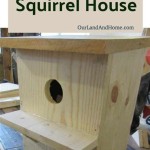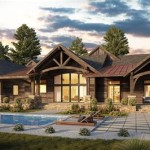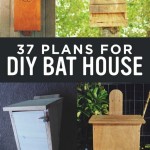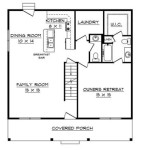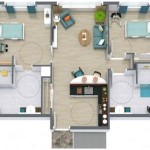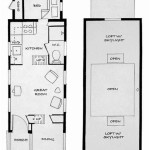Adobe Style House Plans are architectural blueprints that detail the design and construction of houses built using adobe, a natural building material composed of earth, sand, straw, and water. These plans provide a comprehensive guide for builders, contractors, and homeowners, defining the structural elements, room layouts, and aesthetic features of the dwelling. Adobe houses, known for their thermal mass, durability, and unique earthy aesthetic, have been constructed for centuries in various regions worldwide, including the American Southwest, Mexico, and parts of the Middle East.
Adobe Style House Plans encompass a range of architectural styles, from traditional Pueblo-inspired designs to modern and contemporary interpretations. The plans often incorporate sustainable and environmentally conscious features, such as passive solar design, natural ventilation, and rainwater harvesting systems. Given the unique properties of adobe as a building material, these plans require careful consideration of factors such as soil composition, climate conditions, and local building codes to ensure structural integrity and longevity.
As we delve into the main body of this article, we will explore the benefits and considerations associated with Adobe Style House Plans. We will discuss the history, construction techniques, design elements, and modern applications of these plans, providing insights for architects, builders, and individuals interested in creating sustainable and timeless homes.
Adobe Style House Plans offer a unique blend of sustainability, durability, and aesthetic appeal. Here are ten important points to consider:
- Sustainable and eco-friendly
- Energy-efficient and thermally stable
- Durable and low-maintenance
- Fire-resistant and pest-resistant
- Versatile and customizable design
- Natural and organic aesthetic
- Cultural and historical significance
- Cost-effective in some regions
- May require specialized construction skills
- Prone to moisture damage if not properly maintained
By understanding these key points, architects, builders, and homeowners can make informed decisions when considering Adobe Style House Plans for their construction projects.
Sustainable and eco-friendly
Adobe Style House Plans are inherently sustainable and eco-friendly due to the use of adobe as the primary building material. Adobe is composed of natural and renewable resources, such as earth, sand, straw, and water, which significantly reduces the environmental impact associated with its production and transportation compared to conventional building materials like concrete and steel.
The thermal mass of adobe provides excellent insulation, helping to regulate indoor temperatures naturally. This reduces the need for energy-intensive heating and cooling systems, resulting in lower energy consumption and greenhouse gas emissions. Additionally, adobe’s ability to absorb and release moisture helps to create a comfortable and healthy indoor environment, reducing the reliance on artificial ventilation and air conditioning.
Adobe construction techniques minimize waste and promote resource conservation. The use of local and readily available materials reduces transportation distances and the associated environmental impact. Moreover, adobe structures are highly durable and can last for centuries with proper maintenance, reducing the need for frequent renovations or replacements that contribute to construction waste.
Overall, Adobe Style House Plans offer a sustainable and eco-friendly approach to home construction, promoting energy efficiency, resource conservation, and a reduced environmental footprint.
By embracing Adobe Style House Plans, architects, builders, and homeowners can contribute to a more sustainable built environment while creating healthy and comfortable living spaces.
Energy-efficient and thermally stable
Adobe Style House Plans offer exceptional energy efficiency and thermal stability due to the unique properties of adobe as a building material. Adobe’s high thermal mass, combined with its insulating properties, provides excellent temperature regulation, reducing the need for energy-intensive heating and cooling systems.
The thermal mass of adobe absorbs and stores heat during the day, releasing it gradually at night, creating a naturally comfortable indoor environment. This thermal flywheel effect helps to minimize temperature fluctuations, reducing the reliance on artificial heating and cooling. Additionally, adobe’s insulating properties prevent heat loss during the winter and heat gain during the summer, further contributing to energy savings.
In regions with extreme temperature variations, Adobe Style House Plans can provide significant energy savings compared to conventional construction methods. The thick adobe walls act as a buffer, absorbing and releasing heat slowly, reducing the impact of outdoor temperature fluctuations on the indoor environment. This passive temperature control can lead to lower energy consumption and reduced utility bills.
Furthermore, Adobe Style House Plans often incorporate sustainable design principles, such as passive solar design and natural ventilation. By strategically positioning windows and openings to capture sunlight and promote air flow, these plans enhance energy efficiency and create a comfortable indoor environment while reducing the need for artificial lighting and mechanical ventilation.
Overall, Adobe Style House Plans offer a thermally stable and energy-efficient approach to home construction, providing year-round comfort and reducing energy consumption and operating costs.
By embracing Adobe Style House Plans, architects, builders, and homeowners can create energy-efficient and thermally stable homes, contributing to a more sustainable built environment and reducing their energy footprint.
Durable and low-maintenance
Adobe Style House Plans offer exceptional durability and low-maintenance requirements, ensuring the longevity and ease of upkeep of the structure. Adobe, as a building material, possesses inherent properties that contribute to its durability and resilience:
- Resistance to weathering: Adobe’s composition of earth, sand, and straw provides natural resistance to weathering elements. It can withstand prolonged exposure to sunlight, rain, and wind without significant deterioration. The dense and compact nature of adobe walls prevents moisture penetration, reducing the risk of structural damage caused by water infiltration.
- Fire resistance: Adobe is a non-combustible material, providing excellent fire resistance. Its high thermal mass prevents the spread of flames and reduces fire damage to the structure. Adobe buildings have been known to withstand intense fires, protecting the occupants and the property within.
- Pest resistance: Adobe’s composition makes it naturally resistant to pests, such as termites and rodents. The dense and compact structure of adobe walls provides a physical barrier, preventing pests from entering or nesting within the building. This inherent pest resistance contributes to the longevity and structural integrity of Adobe Style House Plans.
In addition to the inherent durability of adobe, Adobe Style House Plans often incorporate design features that enhance low-maintenance requirements:
- Minimal exterior maintenance: Adobe walls require minimal exterior maintenance compared to conventional materials. They do not require painting or regular sealing, as the natural patina of adobe ages gracefully over time. Periodic cleaning and occasional repairs may be necessary to maintain the aesthetic appearance and structural integrity.
- Natural thermal regulation: The thermal mass of adobe provides natural thermal regulation, reducing the need for energy-intensive heating and cooling systems. This reduces maintenance costs associated with HVAC systems and contributes to long-term energy savings.
Overall, Adobe Style House Plans offer a durable and low-maintenance approach to home construction, ensuring the longevity and ease of upkeep of the structure. By embracing the inherent properties of adobe and incorporating sustainable design features, architects, builders, and homeowners can create homes that stand the test of time while minimizing maintenance requirements.
By choosing Adobe Style House Plans, homeowners can enjoy the benefits of a durable and low-maintenance home, reducing the financial burden and time commitment associated with ongoing upkeep. This allows them to focus on enjoying their living space rather than constantly worrying about repairs and maintenance.
Fire-resistant and pest-resistant
Adobe Style House Plans offer exceptional fire resistance and pest resistance, providing homeowners with peace of mind and structural integrity:
- Fire resistance:
Adobe is a non-combustible material, providing excellent fire resistance. Its high thermal mass prevents the spread of flames and reduces fire damage to the structure. Adobe buildings have been known to withstand intense fires, protecting the occupants and the property within. The dense and compact nature of adobe walls acts as a barrier against fire penetration, slowing down the spread of flames and providing valuable time for evacuation and fire suppression.
- Pest resistance:
Adobe’s composition makes it naturally resistant to pests, such as termites and rodents. The dense and compact structure of adobe walls provides a physical barrier, preventing pests from entering or nesting within the building. Adobe’s natural alkalinity also deters wood-boring insects and other pests that may damage conventional wooden structures. This inherent pest resistance contributes to the longevity and structural integrity of Adobe Style House Plans, reducing the need for chemical pest control treatments and minimizing the risk of structural damage caused by pests.
The fire-resistant and pest-resistant properties of Adobe Style House Plans offer significant advantages in terms of safety, durability, and peace of mind. By choosing adobe as the primary building material, homeowners can create homes that are resilient to fire and pests, ensuring the well-being of their families and the longevity of their property.
Versatile and customizable design
Adobe Style House Plans offer exceptional versatility and customizable design, allowing architects and homeowners to create unique and personalized living spaces:
- Adaptable to various architectural styles:
Adobe’s natural aesthetic blends harmoniously with a wide range of architectural styles, from traditional Pueblo and Spanish Colonial to contemporary and modern designs. Adobe homes can be designed to fit into diverse geographic settings, from desert landscapes to mountain terrains, seamlessly complementing the surrounding environment.
- Flexible floor plans and room layouts:
Adobe’s structural flexibility allows for the creation of flexible floor plans and room layouts. The thick adobe walls provide ample support, reducing the need for load-bearing interior walls. This flexibility enables architects to design open and spacious interiors, as well as cozy and intimate spaces, catering to the specific needs and preferences of homeowners.
- Customizable exterior and interior details:
Adobe Style House Plans provide ample opportunities for customization of exterior and interior details. The natural texture and color of adobe can be complemented with a variety of finishes, such as stucco, plaster, or paint, allowing homeowners to create a unique aesthetic that reflects their personal style. Interior details, such as fireplaces, niches, and built-in furniture, can be incorporated into the design to enhance functionality and add a touch of traditional charm.
- Sustainable and site-specific design:
Adobe Style House Plans can be tailored to specific site conditions and incorporate sustainable design principles. The thermal mass of adobe can be strategically utilized to optimize passive solar heating and cooling, reducing energy consumption and environmental impact. Additionally, adobe’s natural composition and local availability contribute to sustainable and site-specific designs that minimize transportation costs and promote harmony with the surrounding landscape.
The versatility and customizable design of Adobe Style House Plans empower architects and homeowners to create unique and personalized living spaces that meet their aesthetic, functional, and environmental aspirations. By embracing the inherent flexibility of adobe, these plans offer endless possibilities for creativity and innovation in residential design.
Natural and organic aesthetic
Adobe Style House Plans embrace a natural and organic aesthetic that seamlessly blends with the surrounding environment. The use of adobe as the primary building material creates a unique and earthy aesthetic that evokes a sense of connection to the land.
The natural texture and color of adobe walls add warmth and character to the interior and exterior spaces. The thick walls provide a sense of solidity and permanence, while the rounded corners and organic shapes create a welcoming and inviting atmosphere. Adobe’s natural composition and warm earthy tones harmonize with the surrounding landscape, creating a sense of continuity between the built environment and the natural world.
In addition to its aesthetic appeal, the natural and organic qualities of adobe contribute to the sustainability and energy efficiency of Adobe Style House Plans. Adobe’s thermal mass helps regulate indoor temperatures, reducing the need for energy-intensive heating and cooling systems. The natural breathability of adobe allows for effective moisture management, creating a healthy and comfortable indoor environment.
Overall, Adobe Style House Plans offer a unique and organic aesthetic that celebrates the beauty and simplicity of natural materials. By incorporating adobe into their designs, architects and homeowners can create living spaces that are not only visually appealing but also sustainable and connected to the natural world.
The natural and organic aesthetic of Adobe Style House Plans appeals to individuals who value sustainability, authenticity, and a connection to the earth. These plans offer a unique opportunity to create homes that are both beautiful and environmentally conscious, promoting a harmonious relationship between architecture and the natural world.
Cultural and historical significance
Adobe Style House Plans hold significant cultural and historical value, reflecting the architectural heritage and traditions of various cultures around the world:
Indigenous origins and cultural continuity:
Adobe construction has been practiced for centuries by indigenous communities in the American Southwest, Mexico, and other regions. Adobe homes were integral to the cultural identity and way of life of these communities, providing shelter, thermal comfort, and a sense of place. Adobe Style House Plans continue to preserve and celebrate these indigenous architectural traditions, fostering cultural continuity and honoring the heritage of the original inhabitants of the land.
Historical landmarks and architectural preservation:
Many historic landmarks and buildings around the world are constructed using adobe. These structures represent significant periods in history and showcase the architectural styles and techniques of past civilizations. Adobe Style House Plans contribute to the preservation and restoration of these historical treasures, ensuring their longevity and educational value for future generations.
Cultural expression and regional identity:
Adobe architecture is deeply rooted in the cultural identity of many regions. The use of local materials and traditional construction methods reflects the unique character and heritage of each area. Adobe Style House Plans embrace this cultural expression, allowing homeowners to connect with the history and traditions of their surroundings.
Architectural legacy and modern adaptations:
Adobe construction techniques have evolved over time, incorporating modern materials and design elements while preserving the essence of traditional adobe architecture. Adobe Style House Plans draw inspiration from historical precedents while adapting to contemporary lifestyles and building codes. This blend of tradition and innovation ensures that adobe architecture remains relevant and vibrant in the modern world.
Preserving and celebrating the cultural and historical significance of Adobe Style House Plans is essential for maintaining a connection to our past and fostering a sense of place. These plans offer a unique opportunity to honor architectural heritage, support cultural diversity, and create living spaces that are both beautiful and meaningful.
Cost-effective in some regions
Adobe Style House Plans can be cost-effective in certain regions where adobe as a building material is readily available and local labor costs are relatively low. Here are a few key factors contributing to the cost-effectiveness of adobe construction in these areas:
- Local material availability:
Adobe is composed of natural materials such as earth, sand, and straw, which are often found in abundance in regions with arid or semi-arid climates. The local availability of these materials significantly reduces transportation costs and makes adobe construction more affordable compared to using materials that need to be imported from distant locations.
- Simplified construction techniques:
Adobe construction techniques have been refined over centuries and are relatively straightforward to implement. Adobe bricks are typically hand-molded and sun-dried, eliminating the need for complex machinery or specialized labor. This simplicity in construction can lead to lower labor costs and shorter construction timelines.
- Energy efficiency:
Adobe’s thermal mass provides excellent insulation, reducing the need for energy-intensive heating and cooling systems. This energy efficiency can translate into significant savings on utility bills over the lifetime of the home, offsetting some of the initial construction costs.
- Durability and low maintenance:
Adobe structures are known for their durability and low maintenance requirements. The thick adobe walls provide excellent protection against weathering, fire, and pests, minimizing the need for costly repairs and maintenance over time. This durability can lead to long-term savings on upkeep and renovations.
It is important to note that the cost-effectiveness of Adobe Style House Plans can vary depending on specific factors such as the size and complexity of the design, local labor rates, and material availability. However, in regions where adobe is abundant and construction costs are favorable, Adobe Style House Plans can offer a cost-competitive option for building sustainable and durable homes.
May require specialized construction skills
Adobe Style House Plans may require specialized construction skills due to the unique nature of adobe as a building material and the traditional techniques involved in its construction. Here are some key aspects to consider:
Understanding of adobe properties and behavior:
Adobe is a natural material with specific properties that require a deep understanding to work with effectively. Builders need to be familiar with adobe’s thermal mass, moisture absorption, and structural behavior to ensure the proper design and construction of adobe structures. This includes knowledge of soil composition, moisture content, and the appropriate mix ratios for creating durable adobe bricks and mortar.
Traditional construction techniques:
Adobe construction involves traditional techniques that have been passed down through generations. These techniques, such as hand-molding adobe bricks, mixing and applying adobe mortar, and constructing thick load-bearing walls, require specialized skills and experience. Builders need to be proficient in these techniques to ensure the structural integrity and longevity of the adobe structure.
Moisture management and weatherproofing:
Adobe is a porous material that requires careful attention to moisture management and weatherproofing. Builders need to understand how to design and construct adobe structures to minimize moisture penetration and prevent water damage. This includes techniques for creating proper drainage, installing moisture barriers, and applying protective finishes to exterior surfaces.
Seismic considerations:
In areas prone to seismic activity, specialized construction skills are necessary to ensure that Adobe Style House Plans meet seismic codes and regulations. This involves understanding the seismic forces that can act on adobe structures and incorporating appropriate reinforcement and structural elements to resist these forces. This may include the use of seismic straps, reinforced concrete bond beams, and other engineering solutions.
While it is possible for skilled DIY builders to undertake small-scale adobe construction projects, larger and more complex Adobe Style House Plans typically require the expertise of experienced adobe builders or contractors. These professionals possess the specialized skills, knowledge, and experience necessary to ensure the successful design and construction of durable and safe adobe homes.
Prone to moisture damage if not properly maintained
Adobe Style House Plans require careful attention to moisture management to prevent damage to the adobe structure. Adobe is a porous material, meaning it can absorb and retain moisture from the surrounding environment. If not properly maintained, this moisture can penetrate the adobe walls and cause structural issues, mold growth, and deterioration over time.
Moisture penetration:
Moisture can penetrate adobe walls through various sources, including rain, groundwater, and condensation. Rainwater can seep into cracks or gaps in the adobe walls, while groundwater can rise through the soil and be absorbed by the adobe. Condensation can occur when warm, moist air comes into contact with cold adobe surfaces, leading to the formation of water droplets within the walls.
Structural damage:
Moisture penetration can weaken the structural integrity of adobe walls. As adobe absorbs moisture, it expands and becomes softer, reducing its load-bearing capacity. Prolonged exposure to moisture can cause adobe walls to crack, sag, or even collapse in severe cases.
Mold growth:
Moisture provides a favorable environment for mold growth. Mold spores can thrive in damp adobe walls, releasing allergens and irritants that can affect indoor air quality and human health. Mold growth can also lead to discoloration and deterioration of the adobe surface.
To prevent moisture damage, Adobe Style House Plans must incorporate proper moisture management strategies. This includes designing the home to minimize moisture penetration, installing effective drainage systems, and using appropriate finishes and sealants to protect the adobe walls from moisture exposure.










Related Posts

